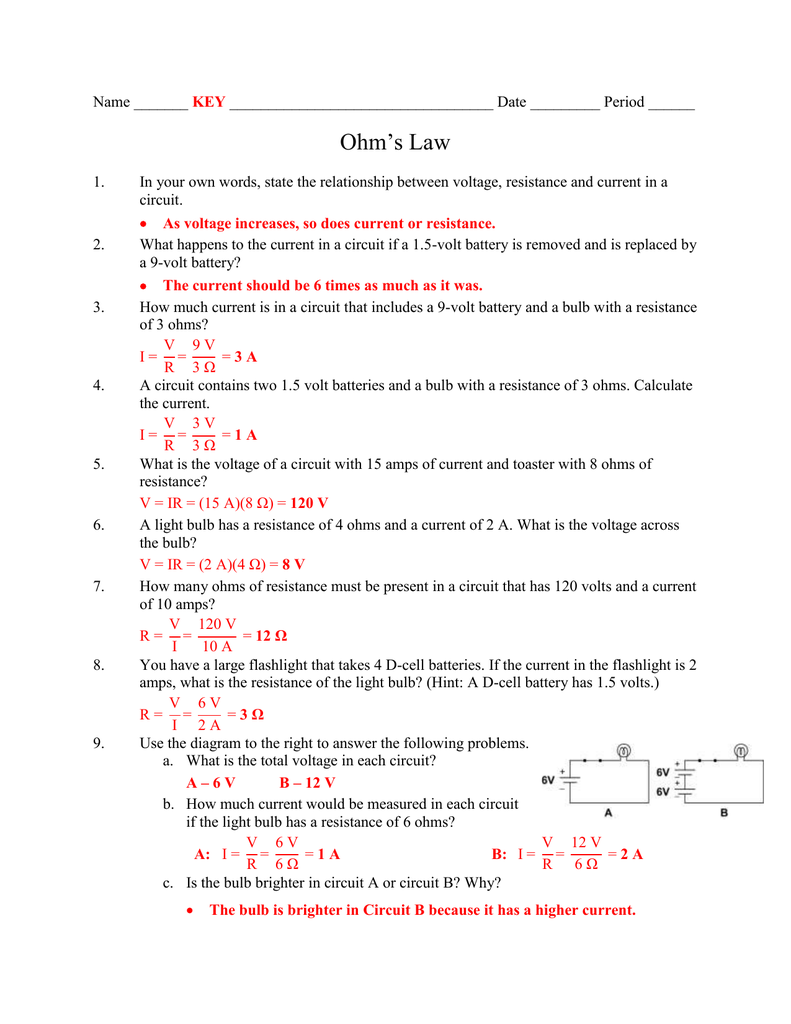Ohm's Law Worksheets: Answers Included for Easy Learning

Ohm's Law is a fundamental principle in electrical engineering that states the current passing through a conductor between two points is directly proportional to the voltage across the two points. This relationship is often expressed through the equation V = IR, where V is the voltage, I is the current, and R is the resistance. Understanding Ohm's Law is crucial for anyone delving into the basics of electricity or aiming to pursue a career in electronics. This blog post will provide a detailed guide on Ohm's Law, including worksheets with answers, to help students and enthusiasts learn this concept effectively.
Purpose of Ohm’s Law

Ohm’s Law serves multiple purposes:
- It helps in understanding and designing circuits where voltage, current, and resistance are key parameters.
- It provides a way to predict how changes in one of these parameters affect the others.
- It’s essential for troubleshooting electrical issues by calculating potential drops and currents in various circuit configurations.

Ohm’s Law Equation

The standard form of Ohm’s Law is:
- V = IR
Where:
- V stands for voltage, measured in volts (V).
- I represents current, measured in amperes (A).
- R denotes resistance, measured in ohms (Ω).
This formula can be rearranged:
- To find current: I = V/R
- To find resistance: R = V/I
Worksheet with Solutions

Here is a worksheet that covers the basics of Ohm’s Law, followed by answers to enhance your understanding:
| Problem | Answer |
|---|---|
| If the voltage across a resistor is 12 V and the current flowing through it is 3 A, what is the resistance? | R = V/I = 12 V / 3 A = 4 Ω |
| If a lightbulb has a resistance of 60 Ω and the voltage across it is 240 V, calculate the current. | I = V/R = 240 V / 60 Ω = 4 A |
| A battery supplies a current of 2 A through a 10 Ω resistor. Determine the voltage supplied by the battery. | V = IR = 2 A * 10 Ω = 20 V |
| The current through a resistor is 5 A, and its resistance is 12 Ω. What is the voltage? | V = IR = 5 A * 12 Ω = 60 V |

Practical Applications of Ohm’s Law

Understanding Ohm’s Law has several practical applications:
- Power calculation: By using Ohm’s Law, you can determine the power dissipated by a resistor with the formula P = VI.
- Circuit design: Engineers use Ohm’s Law to ensure the correct selection of resistors to control current in circuits.
- Troubleshooting: Identifying where potential electrical issues lie by measuring voltage, current, or resistance.
Limitations of Ohm’s Law

It’s important to note that Ohm’s Law applies under certain conditions:
- It assumes that the resistor’s behavior is linear (constant resistance at all voltage levels).
- It does not apply to non-ohmic devices like diodes, which exhibit nonlinear voltage-current characteristics.
- Temperature effects on resistance must also be considered for precise calculations.
⚠️ Note: When performing calculations, ensure units are consistent. Use ohms for resistance, volts for voltage, and amperes for current.
Understanding Ohm's Law not only aids in comprehending basic electrical theory but also equips individuals with the tools needed to design, analyze, and troubleshoot various electrical systems. This post has provided a structured approach to learning Ohm's Law through examples, equations, and practical applications. Remember, consistent practice with these concepts will solidify your understanding, making you more adept at handling electronic circuits and systems.
What are the units for voltage, current, and resistance in Ohm’s Law?

+
Voltage is measured in volts (V), current in amperes (A), and resistance in ohms (Ω).
Can Ohm’s Law be applied to any electrical circuit?

+
While Ohm’s Law applies broadly, it’s specifically accurate for ohmic devices with linear relationships between voltage and current. It does not apply to devices like diodes or where resistance changes with voltage or current.
Why is it important to know Ohm’s Law?

+
Knowing Ohm’s Law is crucial for understanding how electrical components interact in circuits, designing effective circuits, troubleshooting, and calculating power consumption among other applications.
How does temperature affect Ohm’s Law?

+
Most conductors’ resistance changes with temperature. For metals, resistance increases with temperature, affecting the linear relationship assumed by Ohm’s Law.



